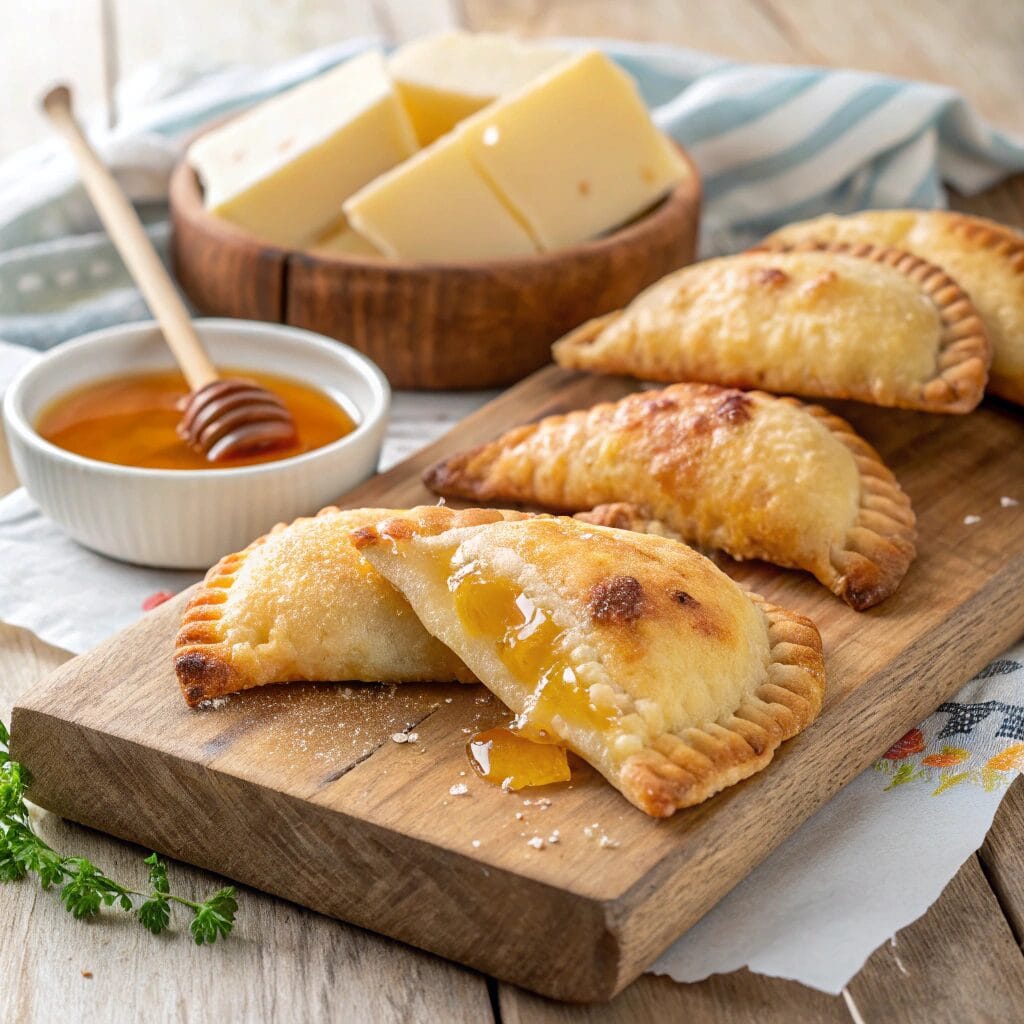Seadas are a traditional Sardinian dessert featuring a crisp pastry filled with melted Pecorino cheese and drizzled with honey. Sardinian shepherds created this sweet‑savory treat using simple rustic ingredients. Now adapted for home kitchens, scones delight with citrus-infused cheese nestled in deep-fried dough. Best enjoyed piping hot and served instantly after drizzling honey, they’re an irresistible blend of tang, sweetness, and crunch.
Why You Will Love the Seadas Recipe
This traditional Sardinian dessert offers a unique harmony of flavors and textures that’s both rustic and elegant.
- The contrast of tangy melted Pecorino cheese and golden crisp pastry delivers an unforgettable bite.
- A touch of lemon or orange zest adds a refreshing brightness that balances the richness.
- Drizzled honey enhances the dessert with floral sweetness and a glossy finish.
- Seadas are perfect for serving warm and fresh—ideal for impressing guests or treating yourself.
- The recipe uses simple ingredients yet produces a sophisticated and deeply comforting dish.
- It offers a taste of authentic Sardinian culture through every rich, sweet, and savory mouthful.
Ingredients You Will Need

Here’s what you’ll need to prepare authentic Sardinian seadas:
- Durum wheat semolina flour: about 200–250 g
- Plain (type 00) flour: optional 50–100 g
- Lard (or butter/olive oil): around 30–50 g
- Young Pecorino cheese (fresh/soured): ~150–300 g
- Lemon and/or orange zest: from one fruit
- Warm water: approx. 100–150 ml
- Salt: a pinch
- Honey (traditional chestnut or strawberry tree honey): for drizzling
- Frying oil (peanut, olive, or sunflower): sufficient for deep frying
How to Make Seadas Recipe
This section explains how to prepare seadas step by step.
Step 1: Make the Dough
Mix semolina (and optional plain flour) with lard, a pinch of salt, and warm water until a smooth elastic dough forms. Rest in fridge for 30 minutes to 2 hours.
Step 2: Prepare the Cheese Filling
Grate young Pecorino and mix with lemon (or orange) zest and a bit of water until pliable or gently warmed into a soft paste.
Step 3: Shape the Seadas
Roll dough thin (~2–3 mm), cut discs (~9–10 cm), place cheese on half, cover with second disc, and seal edges using a fork or rim.
Step 4: Fry and Serve
Heat oil to deep‑frying temperature (around 180–200 °C). Fry until golden on both sides, drain on paper towel, drizzle hot honey immediately, and serve while cheese is molten.

Seadas (Sardinian Fried Cheese Pastries)
Ingredients
Method
- Mix semolina, optional flour, lard, salt, and warm water. Knead into a smooth dough. Chill 30 minutes to 2 hours.
- Grate Pecorino, mix with citrus zest and a little water, or gently warm to form a soft paste.
- Roll dough thin (2–3mm). Cut out 9–10cm discs. Fill with cheese, top with another disc, and seal the edges.
- Heat oil to 180–200°C. Fry seadas until golden on both sides. Drain and drizzle generously with warm honey. Serve hot.
Notes
Serving Tips for Seadas Recipe
Enjoyment is maximized with thoughtful presentation and pairing:
- Serve seadas immediately after frying while cheese is still molten and pastry crisp.
- Drizzle warm honey generously but carefully over each while still sizzling.
- Pair with sweet aromatic white wines like Malvasia di Bosa or Vernaccia di Oristano for an authentic Sardinian experience.
- For easier slicing, let it slightly cool before cutting, though it’s best eaten as whole parcels.
- Use chestnut or strawberry‑tree honey for its traditional bitter‑sweet flavor, or substitute orange‑blossom or thyme honey.
Nutritional Benefits of Seadas Recipe
Seadas offer a blend of protein, energy, and antioxidants. The young Pecorino cheese provides high‑quality protein, calcium, and healthy fats, supporting bone strength. Citrus zest adds vitamin C and aromatic antioxidants. The pastry, made from semolina and lard (or olive oil), delivers complex carbohydrates and monounsaturated fats for energy.
Honey contributes natural sugars and minor antioxidants, creating a sweet finish without refined sugars. Though rich, seadas bring nutritional value when served in moderation, making them an ideal occasional indulgence in a balanced diet.
Conclusion
Seadas combine rustic Sardinian tradition with delightful sensory contrast: crisp golden pastry, stringy cheese infused with citrus, and warm honey. Simple ingredients yield a gourmet dessert that’s elegant yet home‑friendly. Whether shared with guests or savored quietly, seadas offer an unforgettable bite of Mediterranean culinary heritage.
